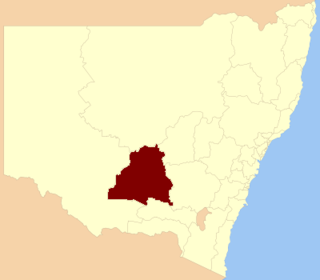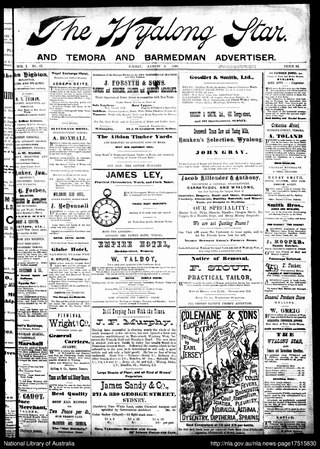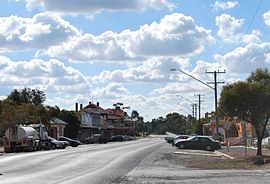
Young is a town in the South Western Slopes region of New South Wales, Australia and the largest town in the Hilltops Region. The "Lambing Flat" Post Office opened on 1 March 1861 and was renamed "Young" in 1863.

Group 9 is a rugby league competition based in Wagga Wagga, New South Wales, Australia, and surrounding areas. The competition is played in six grades, with these being Under 16s, Under 18s, Women's Tackle, Women's League-Tag, Reserve-Grade and First-Grade.

West Wyalong is the main town of the Bland Shire in the Riverina region of New South Wales, Australia. Located 467 kilometres (290 mi) west of Sydney as well as being 262 m (860 ft) above sea level, it is situated on the crossroads of the Newell Highway between Melbourne and Brisbane, and the Mid-Western Highway between Sydney and Adelaide.

Wyalong is part of the Bland Shire located in the Northern Riverina Region of New South Wales, Australia. Established as a gold mining town, it is now a quiet town with historic buildings a few kilometres east of West Wyalong, the major district service centre. At the 2021 census, Wyalong had a population of 620.

Temora is a town in the north-east of the Riverina area of New South Wales, 418 kilometres (260 mi) south-west of the state capital, Sydney. At the 2021 census the population of Temora was 4,016.

Murrumbidgee is a former electoral district of the Legislative Assembly in the Australian state of New South Wales, named after the Murrumbidgee River.

The Northern Riverina Football Netball League (NRFNL) is an Australian rules football and netball competition containing five clubs based in the northern Riverina region of New South Wales, Australia. The league features four grades in the Australian rules football competition, with these being Seniors, Under 17s, Under 14s and Under 11s. In the netball competition, there are five grades, with these being A-Grade, B-Grade, C-Grade, Under 16s and Under 13s.

Bland Shire is a local government area in the Riverina region of New South Wales, Australia. it covers an area of 8,560 square kilometres (3,310 sq mi). As at the 2016 census the population was 5,995. It is a member of the League of Extraordinary Communities which was established by Dull, Perth and Kinross, Scotland, UK and Boring, Oregon, US.

Rankins Springs is a village in the Riverina region of New South Wales, Australia in Carrathool Shire and on the Mid-Western Highway. At the 2011 census, Rankins Springs had a population of 299 residents living in 145 private dwellings. This dropped to 174 in 2016, but rebounded to 208 in 2021. The settlement is strung out along the Mid-Western Highway and adjacent railway line. The main agricultural activities of the district around Rankins Springs are the growing of crops such as wheat and oats, and beef-cattle.

Ungarie is a town in New South Wales, Australia which is the second major town of the Bland Shire, located in the Central West region of New South Wales. It is located 513 kilometres (319 mi) west of Sydney and 615 kilometres (382 mi) north of Melbourne, between the towns of West Wyalong and Lake Cargelligo and is situated 262 metres (860 ft) above sea level. The town's name is derived from an Indigenous Australian word meaning "thigh".

Eric Weissel (;) (1903–1972) was an Australian rugby league footballer, a state and national representative goal-kicking five-eighth. He played his club career in country New South Wales and is considered one of the nation's finest footballers of the 20th century.

Weethalle is a town in the Central West region of New South Wales, Australia. The town is in the Bland Shire local government area and on the Mid-Western Highway, 526 kilometres (327 mi) west of the state capital, Sydney, and 100 kilometres (62 mi) north east of Griffith. At the 2011 census, Weethalle and the surrounding area had a population of 307. The name "Weethalle" is said to be an Aboriginal Australian word for drink. Locals refer to the town as the Wee or the Peethalle.
The West Wyalong Advocate is a weekly, English language newspaper published in West Wyalong, New South Wales, Australia. It has previously been titled The Wyalong Advocate and Mining, Agricultural and Pastoral Gazette.
The Maher Cup was an Australian rugby league challenge cup contested between towns of the South West Slopes and northern Riverina areas of New South Wales between 1920 and 1971. The main teams involved were Cootamundra, Tumut, Gundagai, Temora, West Wyalong, Young, Harden-Murrumburrah, Junee, Barmedman, Cowra, Grenfell and Boorowa.

Kikoira is a town in the Central West region of New South Wales, Australia. The town is in the Bland Shire local government area 548 kilometres (341 mi) west of the state capital, Sydney.
Yiddah is a locality in New South Wales, Australia. The locality is 474 kilometres (295 mi) west of the state capital, Sydney about midway between the towns of West Wyalong and Barmedman. Yiddah is in the Bland Shire local government area and Bland county cadastral area.

The Wyalong Star and Temora and Barmedman Advertiser was an English language newspaper published in Wyalong, New South Wales, Australia.

North Yalgogrin is a locality in the Bland Shire local government area of New South Wales. There once was a village there, named Yalgogrin, but better known as Yalgogrin North.
The West Wyalong Mallee Men are a rugby league club based in the town of West Wyalong in the Riverina region of New South Wales, Australia. Founded in 1911, the team is the joint oldest in the state outside of Sydney and Newcastle alongside the North Tamworth Bears.

Reefton is a locality in the Temora Shire local government area of the Riverina region of New South Wales Australia. It lies on the Goldfields Way, between Temora and West Wyalong, to the south of Barmedman. There was once a gold mining village of the same name, which is now a ghost town. What remains of the second village bearing the name still lies in the locality, on the Lake Cargelligo railway line, and there was once a railway station, also called Reefton. The locality is rural with crop raising and grazing being the main economic activities.



















